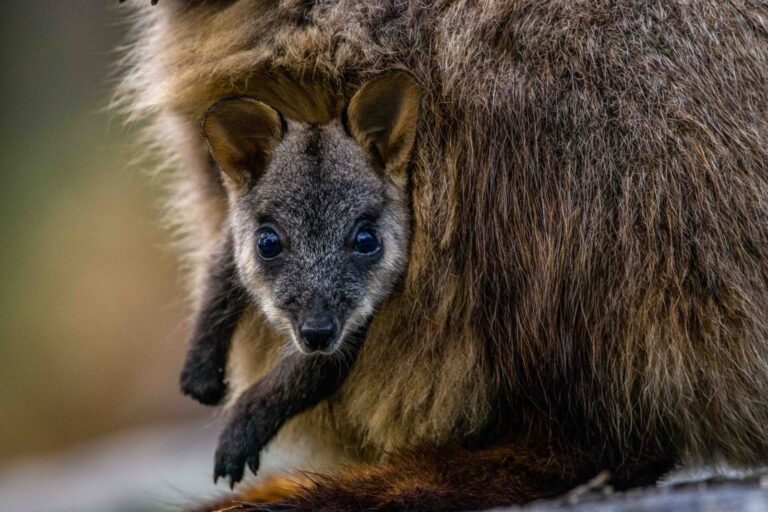
Have you ever seen a brush-tailed rock-wallaby?
Probably not, and here’s why…
- They only live on the steepest cliff faces
- There are just 30 rock-wallabies left in Kangaroo Valley
- They are active at dusk and overnight.
Kangaroo Valley may be named after its kangaroos. But what about its brush-tailed rock-wallabies?
Whilst kangaroos are abundant across Australia, rock-wallabies are rare. Kangaroo Valley is lucky to host one of the last remnant populations ofthem… in fact these are the southern-most rock-wallabies in NSW.
These are special animals. They are excellent rock climbers, with ‘suction feet’ that help them grip and long bushy tails that aid their balance. Female rock-wallabies protect their joeys in their pouches. But when pouch joeys get too big, they may cause their mothers to lose their balance and fall off the cliffs. The rock-wallabies then have no choice but to stash their joeys in rock crevices whilst they forage.
These joey rock-wallabies are vulnerable to predators – foxes, dogs and cats all present major threats.
So, how are the Kangaroo Valley rock-wallabies faring? The good news is that their numbers have steadily grown over the last two decades, from eight in 2009 to 34 in 2021. They narrowly escaped the 2020 bushfires, but this is still a small and vulnerable population. Right now, there are not enough breeding females… and 10 of the 11 joeys born in the last three years have been males.
Will Kangaroo Valley watch on as there is a possible extinction on its doorstep?
The Friends of the Brush-Tailed Rock-Wallaby were founded by Valley locals who were determined to fight to conserve these ‘little fellas’. 25 years on, this Kangaroo Valley based conservation organisation remains committed to building up a thriving population of rock-wallabies for future generations in the Valley to enjoy. The Friends work closely with NSW National Parks and Wildlife Service to actively protect rock-wallabies – controlling foxes, monitoring rock-wallaby colonies and tracking individuals using radio collars.
Every KV rock-wallaby has a name and can be identified through its ear notches and chest patterns. KV public schoolchildren suggested names last year and this year the Friends ran a naming competition. Frolic, Banjo, Rocky and Tenzin have been duly named!
So what next? Our community have made fantastic progress and we need to keep up the good work to continue to sustain the numbers. And it is time to look beyond this. Eventually the goal is to be able to create a larger more sustainable population. But to do this requires an understanding of how they disperse, detailed research into past and future suitable habitat for the future, and to search the broader Illawarra area for relic populations. The next few years bring exciting and rewarding work.
The Friends’ new president, Jerry Connor, is keen to bring in more volunteers and fresh ideas. “I believe the rock-wallabies are one of those things that are special to Kangaroo Valley. They deserve our support and protection. We would love to hear from others in the Valley who are passionate about conservation and would like to get involved in the Friends. We need all the support we can get!”
To find out more about the Friends of the Brush-Tailed Rock-Wallaby, follow us on Facebook or visit rockwallaby.org.au. To get involved, please contact friends@rockwallaby.org.au.
Rosie Connor
image: Joeys are at risk from foxes, dogs and cats